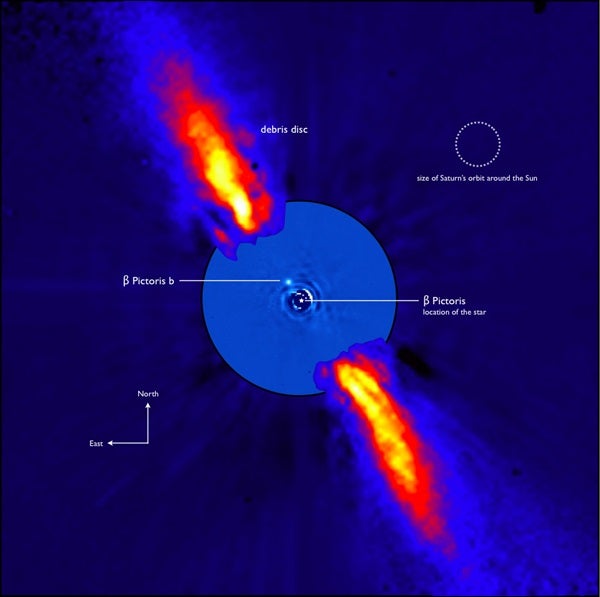Only 12 million years old, the “baby star” Beta Pictoris lies about 70 light-years away toward the constellation Pictor the Painter. The hot star is one of the best-known examples of stars surrounded by a dusty “debris” disk. Collisions between larger bodies like planetary embryos or asteroids give off the dust that makes up such disks. They are a bigger version of the zodiacal dust in our solar system.
Beta Pictoris’ disk was the first to be imaged — as early as 1984 — and remains the best-studied system. Earlier observations showed a warp of the disk, a secondary inclined disk, and infalling comets onto the star.
“These are indirect, but telltale signs that strongly suggest the presence of a massive planet lying between 5 and 10 times the mean Earth-Sun distance from its host star,” said team leader Anne-Marie Lagrange. “However, probing the very inner region of the disk, so close to the glowing star, is a most challenging task.”
In 2003, the French team used the Nasmyth Adaptive Optics System Near-Infrared Imager and Spectrograph (NAOS-CONICA) instrument (or NaCo), mounted on one of the 8.2-meter Unit Telescopes of European Southern Observatory’s Very Large Telescope (VLT), to study the immediate surroundings of Beta Pictoris.
Recently, a team member reanalyzed the data in a different way to seek the trace of a companion to the star. Infrared wavelengths are well-suited for such searches. “For this, the real challenge is to identify and subtract as accurately as possible the bright stellar halo,” said Lagrange. “We were able to achieve this after a precise and drastic selection of the best images recorded during our observations.”
The astronomers were able to discern a feeble, point-like glow well inside the star’s halo. To eliminate the possibility that this was an artifact and not a real object, the team conducted a battery of tests. This independent analysis led to the same result. Moreover, other data sets discovered the companion, further supporting the team’s conclusion: The companion is real.
“Our observations point to the presence of a giant planet, about 8 times as massive as Jupiter and with a projected distance from its star of about 8 times the Earth-Sun distance, which is about the distance of Saturn in our solar system,” said Lagrange.
“We cannot yet rule out definitively, however, that the candidate companion could be a foreground or background object,” said co-worker Gael Chauvin. “To eliminate this very small possibility, we will need to make new observations that confirm the nature of the diskovery.”
The team also dug into the archives of the Hubble Space Telescope but couldn’t see anything, “while most possible foreground or background objects would have been detected,” said another team member, David Ehrenreich.
The fact that the candidate companion lies in the disk’s plane also implies that it is bound to the star and its proto-planetary disk.
“Moreover, the candidate companion has exactly the mass and distance from its host star needed to explain all the disk’s properties. This is clearly another nail in the coffin of the false alarm hypothesis,” said Lagrange.
When confirmed, this candidate companion will be the closest planet from its star ever imaged. In particular, it will be located well inside the orbits of the outer planets of the solar system. Several other planetary candidates have been imaged, but they are all located farther away from their host star: If they were located in our solar system, they would lie close or beyond the orbit of the farthest planet, Neptune. The formation processes of these distant planets are likely to be quite different from those in Beta Pictoris.
“Direct imaging of extrasolar planets is necessary to test the various models of formation and evolution of planetary systems. But such observations are only beginning. Limited today to giant planets around young stars, they will in the future extend to the detection of cooler and older planets, with the forthcoming instruments on the VLT and on the next generation of optical telescopes,” said team member Daniel Rouan.










